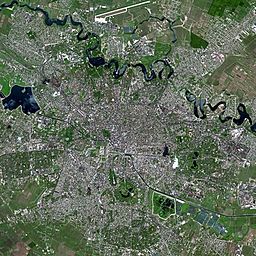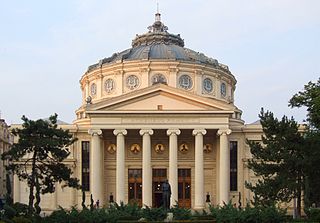
Bucharest is the capital and largest city of Romania. The metropolis stands on the River Dâmbovița in south-eastern Romania. Its population is officially estimated at 1.76 million residents within a greater metropolitan area of 2.3 million residents, which makes Bucharest the 8th most-populous city in the European Union. The city area measures 240 km2 and comprises 6 districts (Sectoare), while the metropolitan area covers 1,811 km2. Bucharest is a beta global city, a major cultural, political and economic hub, and the country's seat of government.

Bucharest Henri Coandă International Airport is Romania's busiest international airport, located in Otopeni, 16.5 km (10.3 mi) north of Bucharest's city centre. It is currently one of the two airports serving the capital of Romania. The other is Aurel Vlaicu Airport. The airport covers 605 hectares of land and contains two parallel runways, both 3,500 meters long.

The Bucharest Metro is an underground rapid transit system that serves Bucharest, the capital of Romania. It first opened for service on 16 November 1979. The network is run by Metrorex. One of two parts of the larger Bucharest public transport network, Metrorex has an average of approximately 720,000 passenger trips per weekday, compared to the 1,180,000 daily riders on Bucharest's STB transit system. In total, the Metrorex system is 79.1 kilometres (49.2 mi) long and has 64 stations.

Piatra Neamț is the capital city of Neamț County, in the historical region of Western Moldavia, in northeastern Romania. Because of its very privileged location in the Eastern Carpathian mountains, it is considered one of the most picturesque cities in Romania. The Nord-Est Regional Development Agency is located in Piatra Neamț.

Maia Emilia Ninel Morgenstern is a Romanian film and stage actress, described by Florin Mitu of AMOS News as "a symbol of Romanian theater and film". In the English-speaking world, she is best known for portraying the Blessed Virgin Mary in Mel Gibson's The Passion of the Christ. In Romania, she has been nationally known since her 1992 role as Nela in Balanța, a film known in the United States as The Oak, set during the waning days of Communist Romania. She received a star on the Romanian Walk of Fame in Bucharest on 1 May 2011.

Snagov is a commune, located 40 km (25 mi) north of Bucharest, in Ilfov County, Muntenia, Romania. The commune is composed of five villages: Ciofliceni, Ghermănești, Snagov, Tâncăbești, and Vlădiceasca. Snagov is a tourist and spa resort, but the necessary infrastructure has regressed after 1989. At the 2021 census, the commune had a population of 8,331.

Nicolae Grigorescu was one of the founders of modern Romanian painting.

Constantin Brâncoveanu is a metro station in Bucharest. It is named after Constantin Brâncoveanu, a Wallachian prince (1654–1714).

The Municipality of Bucharest is divided into 6 administrative units, named sectors, each of which has their own mayor and council, and has responsibility over local affairs, such as secondary streets, parks, schools and the cleaning services.

Sector 4 is an administrative unit of Bucharest.

Fotbal Club Unirea Urziceni, commonly known as Unirea Urziceni, was a Romanian professional football club based in Urziceni, Ialomița County. Unirea became national champions in 2009, at the end of their third season in the top-flight.
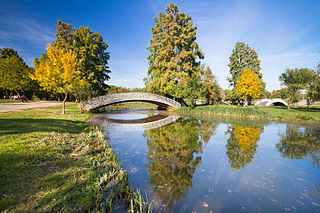
Tineretului Park is a large public park in southern Bucharest.

Carol I Park is a public park in Bucharest, Romania, named after King Carol I of Romania. A French garden located in the southern-central area of Bucharest, partly on Filaret hill, originally capable of hosting various exhibitions, it suffered considerable modifications during the communist regime, including a name change to Parcul Libertății.
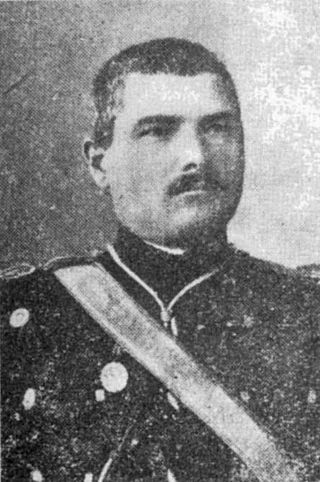
Tudor Pamfile was a Romanian writer.
George Anania was a Romanian science-fiction writer and translator.
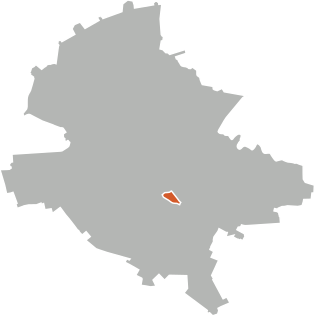
Tineretului is a small (0,62 km2) neighborhood in south Bucharest, Romania in Sector 4, close to the city center, named after the nearby Tineretului Park. It is one of the preferred neighborhoods by people seeking to buy an apartment. This is due to the well established public transportation, two nearby parks; along with banks, commercial spaces and schools. In 2015 there were a number of 17.981 people registered living in this area.

Polyvalent Hall of Bucharest is a multi-purpose indoor arena on the Tineretului Park in Bucharest, Romania. It is home to the CSM București of the National Handball League (LNHF). With a seating capacity of 5,300, the Sala Polivalentă also regularly hosts concerts, conventions and shows.

Văcărești Nature Park is a nature park located in Sector 4 of Bucharest, Romania, containing the wetlands surrounding Lake Văcărești.

Stadionul Tineretului is a multi-use stadium in Oradea, Romania. The stadium was opened on 4 June 1895 as part of the sports pavilion of the Rhédey Garden. Located in the southwestern part of the city between Nicolae Bălcescu Park and Oradea Zoological Garden, the stadium is considered to be the birthplace of many sports in the city located on the banks of the Crișul Repede river. Besides historical and sentimental value, the arena has also an architectural value, in the northern end of the stadium being a ground floor building and two small towers originally built to serve for dancing, a new restaurant and a buffet. The building is the work of famous architects Kálmán Rimanóczy Sr. and Kálmán Rimanóczy Jr.

